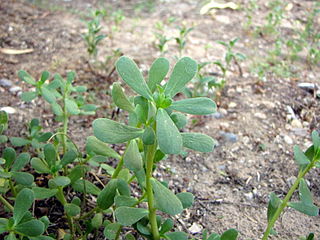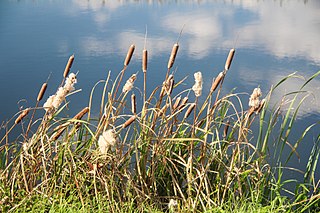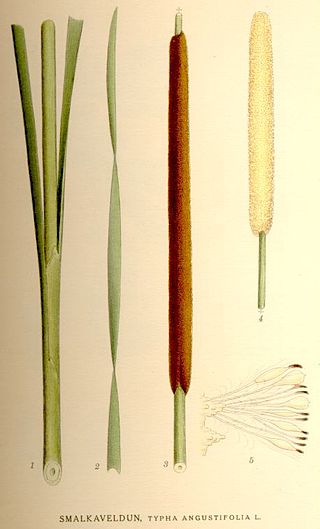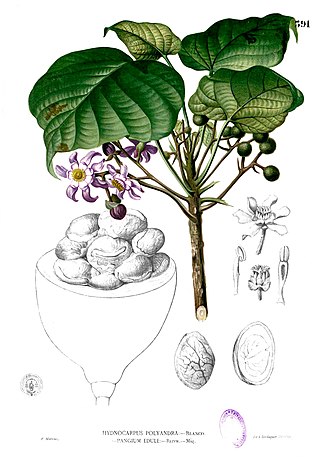
Common chicory is a somewhat woody, perennial herbaceous plant of the family Asteraceae, usually with bright blue flowers, rarely white or pink. Native to the Old World, it has been introduced to the Americas and Australia.

Morus, a genus of flowering plants in the family Moraceae, consists of diverse species of deciduous trees commonly known as mulberries, growing wild and under cultivation in many temperate world regions. Generally, the genus has 64 subordinate taxa, three of which are well-known and are ostensibly named for the fruit color of the best-known cultivar: white, red, and black mulberry, with numerous cultivars and some taxa currently unchecked and awaiting taxonomic scrutiny. M. alba is native to South Asia, but is widely distributed across Europe, Southern Africa, South America, and North America. M. alba is also the species most preferred by the silkworm, and is regarded as an invasive species in Brazil and the United States.

Sassafras is a genus of three extant and one extinct species of deciduous trees in the family Lauraceae, native to eastern North America and eastern Asia. The genus is distinguished by its aromatic properties, which have made the tree useful to humans.

Matricaria discoidea, commonly known as pineappleweed, wild chamomile, disc mayweed, and rayless mayweed, is an annual plant native to North America and introduced to Eurasia where it grows as a common herb of fields, gardens, and roadsides. It is in the daisy family Asteraceae. The flowers exude a chamomile/pineapple aroma when crushed. They are edible and have been used in salads and to make herbal tea.

Watercress or yellowcress is a species of aquatic flowering plant in the cabbage family Brassicaceae.

Portulaca oleracea is an annual succulent in the family Portulacaceae.

Allium canadense, the Canada onion, Canadian garlic, wild garlic, meadow garlic and wild onion is a perennial plant native to eastern North America from Texas to Florida to New Brunswick to Montana. The species is also cultivated in other regions as an ornamental and as a garden culinary herb. The plant is also reportedly naturalized in Cuba.

Typha latifolia, better known as broadleaf cattail, is a perennial herbaceous plant in the genus Typha. It is found as a native plant species in North and South America, Eurasia, and Africa. The T. latifolia genome was published in 2022.

Rumex acetosella, commonly known as red sorrel, sheep's sorrel, field sorrel and sour weed, is a species of flowering plant in the buckwheat family Polygonaceae. Native to Eurasia and the British Isles, the plant and its subspecies are common perennial weeds. It has green arrowhead-shaped leaves and red-tinted deeply ridged stems, and it sprouts from an aggressive and spreading rhizome. The flowers emerge from a tall, upright stem. Female flowers are maroon in color.

Potentilla indica, known commonly as mock strawberry, Indian-strawberry, or false strawberry, often referred to as a backyard strawberry, mainly in North America, is a flowering plant in the family Rosaceae. It has foliage and an aggregate accessory fruit similar to that of a true strawberry. It has yellow flowers, unlike the white or slightly pink flowers of true strawberries. It is native to eastern and southern Asia, but has been introduced to many other areas as a medicinal and an ornamental plant, subsequently naturalizing in many regions worldwide.

Vitis californica, with common names California wild grape, Northern California grape, and Pacific grape, is a wild grape species widespread across much of California as well as southwestern Oregon.

Hemerocallis fulva, the orange day-lily, tawny daylily, corn lily, tiger daylily, fulvous daylily, ditch lily or Fourth of July lily, is a species of daylily native to Asia. It is very widely grown as an ornamental plant in temperate climates for its showy flowers and ease of cultivation. It is not a true lily in the genus Lilium, but gets its common name from the superficial similarity of its flowers to Lilium and from the fact that each flower lasts only one day.

Vaccinium parvifolium, the red huckleberry, is a species of Vaccinium native to western North America.

Typha angustifolia L. is a perennial herbaceous plant of genus Typha. This cattail is an "obligate wetland" species that is commonly found in the northern hemisphere in fresh water or brackish locations.

Antidesma bunius is a species of fruit tree in the family Phyllanthaceae. It is native to Southeast Asia and northern Australia. Its common Philippine name and other names include bignay, bugnay or bignai, Chinese-laurel, Queensland-cherry, salamander-tree, wild cherry, and currant tree.

Viburnum edule, the squashberry, mooseberry, moosomin, moosewood viburnum, pembina, pimina, highbush cranberry, or lowbush cranberry is a species of shrub native to Canada and the northern parts of the US. It stands roughly 2 m (6.5 ft) tall with many stems and smooth branches.

Pangium is a genus in the family Achariaceae containing the sole species Pangium edule, a tall tree native to the mangrove swamps of Southeast Asia. It produces a large poisonous fruit which can be made edible by fermentation. It is dioecious, with male and female flowers produced on separate individuals.

Flacourtia inermis, known commonly as lovi-lovi, or batoko plum, is a species of flowering plant native to the Philippines and Indonesia, but which has naturalized around the edges of tropical Asia and Africa. Common names in Indonesia include Tome-Tome, Lovi-lovi, and lobi-lobi.

The flora of Qatar includes more than 300 species of wild plants. Qatar occupies a small desert peninsula that is around 80 km from east to west and 160 km from north to south. The climate is hot and humid with sporadic rain. Majority of the country is flat with an annual rainfall average of less than 3 inches. Arnebia hispidissim blooms yellow flowers annually in sandy soil. Glossonema edule has edible fruits with brownish-yellow flowers.




















